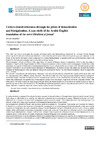Identificador persistente para citar o vincular este elemento:
https://accedacris.ulpgc.es/jspui/handle/10553/76170
| Título: | Culture-bound references through the prism of domestication and foreignization. A case study of the Arabic-English translation of the novel Dhakirat al jassad | Autores/as: | Boudhen, Besma | Clasificación UNESCO: | 570107 Lengua y literatura 550510 Filología |
Palabras clave: | Literary translation Culture-bound references Domestication and foreignization |
Fecha de publicación: | 2020 | Publicación seriada: | LFE. Revista de Lenguas para Fines Específicos | Resumen: | This study sets out to investigate the concepts of domestication and foreignization introduced by Lawrence Venuti through examining the transfer of culture-bound references in the translation of the novel “Dhakirat al jassad
دسجل ا ةركاذ” (Memory in the Flesh) by the world's best-known Arab woman novelist, Ahlam Mosteghanemi. A translation that was carried out from Arabic into English by the Lebanese journalist and translator Baria Ahmar Sreihn.The protagonists (khaled and Hayat) both come from the capital of Eastern Algeria: Constantine, which is also the author’s hometown. Algeria, as the biggest country in Africa, is home to numerous cultures, dialects and even languages. Constantine is thus considered an Algerian cultural and civilization beacon that has its own culture, habits and customs which the Arab reader can feel through the extensive use of culture-bound references by Mosteghanemi. In addition to that, the reader can also feel the French influence in Mosteghanemi’s style, an influence that can be explained by the fact that the French colonialism stayed in Algeria for over 132 years. We selected 14 occurrences of culture-bound references to be analyzed and criticized from the first chapter of the novel. How did the translator deal with a different culture than hers? How did she render all of the Algerian culture-bound references in English? Were they adapted? Omitted? Or kept as they are? According to Lawrence Venuti, the translator should always choose to foreignize rather than domesticate. On another note, Schleirmacher speaks about two major things from which the translator chooses: “He either leaves the writer in peace as much as possible and moves the reader toward him; or he leaves the reader in peace as much as possible and moves the writer toward him.” We therefore put forth the hypothesis that the translator domesticated all of the culture-bound references in order to “move the writer (and her culture) toward the reader”. La présente étude se propose d’investiguer les deux concepts de domestication et d’étrangéisation introduits par Lawrence Venuti. Nous allons en effet analyser le transfert des références culturelles dans la traduction du roman “Dhakirat al Jassad دسجل ا ةركاذ” (Mémoires de la chaire) de la romancière arabophone la plus connue du monde : Ahlam Mosteghanemi. Une traduction qui a été faite de l’arabe vers l’anglais par la journaliste et traductrice libanaise Baria Ahmar Sreihn. Les protagonistes (Khaled et Hayate) sont tous deux natifs de la capitale de l’Est algérien : Constantine, la ville natale de l’auteure. L’Algérie est, en effet, le plus grand pays d’Afrique. Par conséquent, il jouit d’une immense diversité culturelle, dialectale et même linguistique. Constantine est, donc, considérée comme l’un des flambeaux culturels et Friedrich, (els de ce pays. Ayant sa propre culture, habits traditionnels et coutumes, Constantine est présentée au lecteur Arabe grâce à l’utilisation extensive des références culturelles par Mosteghanemi. De plus, l’influence de la langue française peut aussi être perçue dans le style de Mosteghanemi. Une influence qui se justifie par les 132 années de présence coloniale française sur les territoires algériens. Nous avons sélectionné 14 cas de références culturelles du premier chapitre du roman, et ce, aux fins de les analyser et les critiquer. Comment la traductrice a-t- elle abordé une culture si différente de la sienne ? comment a-t- elle rendu toutes les références culturelle algériennes en anglais? ont-elles été adaptées? omises? ou gardées telles quelles? Selon Lawrence Venuti, le traducteur doit toujours choisir d’étrangéiserau lieu de domestiquer. Shleiermacher, lui, parle de deux choix auxquels le traducteur fait face: il doit soit « choisir de laisser l’auteur en paix le plus possible et emmener le lecteur à sa rencontre ou bien laisser le lecteur en paix le plus possible et emmener l’auteur à sa rencontre». De ce fait, nous avons émis l’hypothèse que la traductrice a domestiqué toutes les références culturelles afin d’ «emmener l’auteure (et sa culture) à la rencontré du lecteur ». |
URI: | https://accedacris.ulpgc.es/handle/10553/76170 | ISSN: | 2340-8561 | DOI: | 10.20420/rlfe.2020.318 | Fuente: | LFE. Revista de lenguas para fines específicos [eISSN 2340-8561], v. 26 (1), p. 133-147 |
| Colección: | Artículos |
Los elementos en ULPGC accedaCRIS están protegidos por derechos de autor con todos los derechos reservados, a menos que se indique lo contrario.
